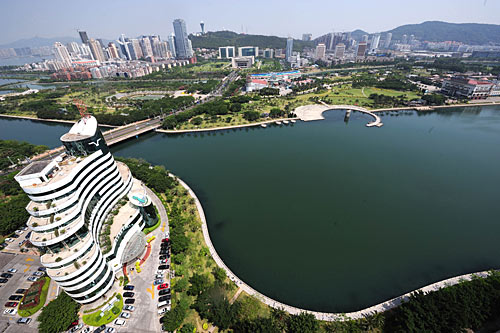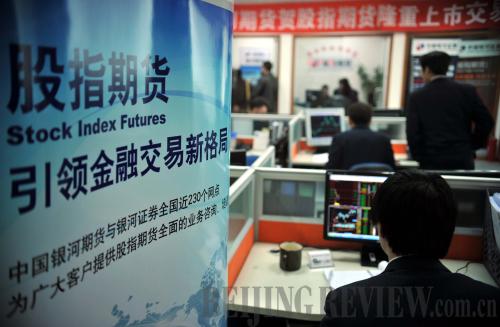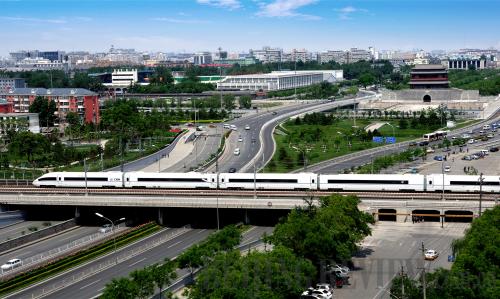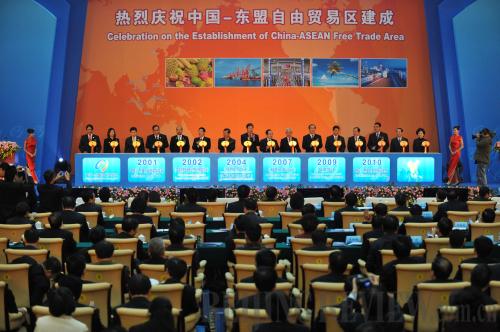|
The bank sold 25.57 billion A-shares on the Shanghai Stock Exchange at 2.68 yuan ($0.4) per share and up to 25.4 billion shares in Hong Kong at HK$3.2 ($0.41) per share, excluding an over-allotment option.
ABC shares on the Shanghai and Hong Kong bourses increased a miniscule 0.75 percent on July 15 and 2.2 percent on July 16, the first days of their respective IPOs.
ABC was the last of China's "big four" state-owned commercial banks to sell shares to the public and its listing marked the end of the banking sector reform that started in 2005.
The bank owns more than 24,000 branches nationwide with more than 350 million customers. Though the second biggest in terms of assets among the "big four," it has always been the weakest link among China's state-owned commercial banks.
From January to September, the bank generated a profit of 70.2 billion yuan ($10.5 billion) in the first three quarters, a growth of 36.3 percent from one year earlier. The bank attributed the buoyant performance to expanding interest income and soaring intermediary businesses.
Balancing Regional Economies
 |
|
(XINHUA) |
This year China continued to narrow the gap in regional development through regional economic revitalization.
On January 4, the State Council issued the Guidelines on Promoting Hainan as an International Tourist Destination, to boost tourism of the island. Hainan received a green light to tap into sports lotteries and open more duty-free shops for departing foreign tourists.
On January 12, the State Council approved Planning for the Wanjiang River Urban Belt as an Industrial Transfer Demonstration Zone. Wanjiang River Urban Belt refers to nine cities along parts of the Yangtze River flowing through Anhui Province. It is closely linked to the Yangtze River Delta geographically and culturally, and is critical to industrial relocation.
In April, the State Council approved a national development strategy for the Shenyang Metropolitan Area covering Shenyang and its eight neighboring cities. The core of this strategy is innovation in industrial development, integration of the eight cities, integration of urban and rural areas as well as interventions toward more market-oriented development.
A massive support package to help Xinjiang Uygur Autonomous Region achieve leapfrog-like development was unveiled at a central work conference on the region's development—the first of its kind in 60 years held in Beijing on May 17-19. A series of preferential policies including the resource tax reform (launched on June 1) were introduced.
The Regional Plan for the Yangtze River Delta was approved by the State Council on May 24. The Yangtze River Delta, embracing the Shanghai Municipality and Jiangsu and Zhejiang provinces, is the most developed region in the country. The plan says the Yangtze River Delta will be developed into a key international gateway for the Asia-Pacific region, an important global center for the modern service industry and advanced manufacturing industry.
Ten years after it unveiled a strategy to promote growth in its western area, China set goals for the western development endeavor over the next decade at a conference on July 5-6. The focus will be on enhancement of the economic strength of the western region to achieve a 10-percent economic growth rate by 2020.
The plan for southwest China's Chengdu-Chongqing economic zone was recently submitted to the State Council for approval. The zone is to include 15 cities in Sichuan Province and 31 districts or counties in Chongqing Municipality. The economic zone is aimed at becoming an economic engine for China's western region, and a base for advanced manufacturing, modern services, advanced technology and agricultural production.
Overseas Investments Soar
 |
|
(WU WEI) |
Chinese companies are looking to expand their footprints beyond China's borders.
China's outbound direct investment (ODI) in non-financial sectors reached $47.56 billion in the first 11 months of this year, covering 122 countries and regions all over the world, said the Ministry of Commerce. The investment mainly flew to Hong Kong, Australia, Sweden, the United States, Canada, Russia and Brazil. The most coveted area was mining, followed by manufacturing, transportation and the services sector.
From January to September, Chinese enterprises were responsible for 38 overseas merger and acquisition deals, equal to 2009's total, say data from the Beijing-based Zero2IPO Research Center.
Private enterprises are also quickly stepping up their games as well. Zhejiang-based Geely Automobile Holdings Ltd. closed a deal in August to purchase Volvo Car Corp. from Ford Motor Co. This was the biggest overseas acquisition in China's auto industry.
Recently, China National Offshore Oil Co. Ltd. teamed up with Argentina-based Bridas Energy Holdings to pay around $7.06 billion for a 60-percent equity interest in Pan American Energy (PAE) from British Petroleum Plc.
Stock Index Futures Debuts
 |
|
(MA YAN) |
China unveiled stock index futures at the China Financial Futures Exchange in Shanghai's Pudong District on April 9. China Securities Index 300, the first of its kind, was traded on April 16.
The launch of stock index futures is a milestone for China's stock market development. It gives investors a mechanism to profit from declines in stock prices, allows them to hedge risks and helps ease market fluctuations.
This year also marks the 20th anniversary of China's stock markets. In the past two decades, China has built up a multi-level stock market system. China's stock market has also become one of the world's largest in terms of market value.
Entering a High-Speed Rail Era
 |
|
(YUAN RUILUN) |
China operates a high-speed railway network with a combined length totaling 7,531 km, the longest in the world, said Minister of Railways Liu Zhijun. An experimental running of China's latest bullet train on the Zaozhuang-Bengbu section of the Beijing-Shanghai line reached a world record speed of 486.1 km per hour on December 3.
Several intercity rail lines, including Zhengzhou-Xi'an, Fuzhou-Xiamen, Chengdu-Dujiangyan, Shanghai-Nanjing, Nanchang-Jiujiang and Shanghai-Hangzhou high-speed railways, were launched this year.
China-ASEAN FTA Launched
 |
|
(ZHOU HUA) |
On January 1, 2010, China and the Association of Southeast Asian Nations (ASEAN) created the China-ASEAN Free Trade Area.
Tariffs of about 90 percent on commodities traded between China and six ASEAN members—Brunei, Malaysia, Indonesia, the Philippines, Singapore and Thailand—were reduced to nearly zero, marking the initial establishment of the free trade area.
The China-ASEAN FTA covers a population of 1.9 billion people and handles a $4.5-trillion trade volume. It is the world's largest FTA for developing countries, the third largest FTA after the North American Free Trade Area and the European Union.
China's average tariff on ASEAN goods decreased from 9.8 percent in 2009 to 0.1 percent, while the six ASEAN members' average tariff on Chinese goods has shrunk from 12.8 percent to 0.6 percent.
By 2015, a zero percent tariff rate for 90 percent of traded goods is expected to extend between China and four other ASEAN members, Cambodia, Laos, Myanmar and Viet Nam.
Boosted by the FTA, China-ASEAN trade topped $263 billion in the first 11 months of this year, an increase of 40.6 percent from a year ago, say figures from the Ministry of Commerce.
E-Commerce Booms
 |
|
(HUANG ZONGZHI) |
The Internet is becoming a hotbed for businesses as e-commerce continues gaining momentum this year.
The e-commerce transaction volume in the country amounted to 3.3 trillion yuan ($496.2 billion) in the first three quarters, compared with 3.6 trillion yuan ($541.4 billion) for the entire year of 2009, said a recent report by the Shanghai-based iResearch Consulting Group.
B2B remains the most vibrant activity, accounting for 88.5 percent of the e-commerce market.
Meanwhile, online shopping is also bursting with vitality as Chinese consumers search for bargains on everything from cosmetics to clothes.
On November 11, Taobao.com, China's largest online shopping marketplace, reported a record daily sales of 936 million yuan ($140.8 million) from its newly launched B2C platform Tmall.com, compared with Hong Kong's average daily retail sales of 850 million yuan ($127.8 million). | 